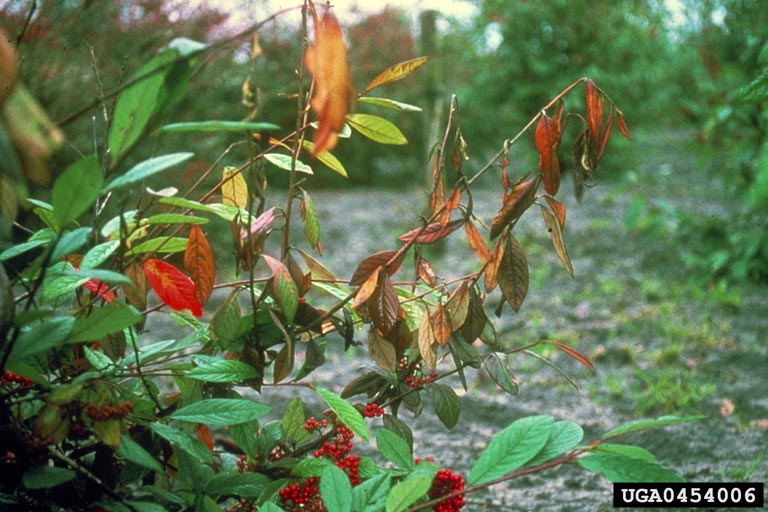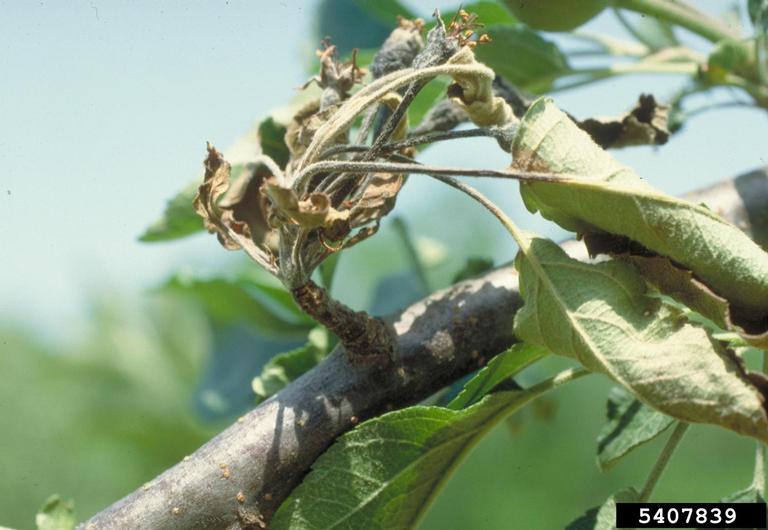
It will be time to start pruning fruit trees later this month. As pruning begins, it's important to have a good skills at identifying fire blight symptoms and have a multi-pronged approach for control, especially in very susceptible trees. Pruning and sanitation are important control strategies, but improper cleaning of pruning equipment between cuts can easily spread the disease.
Fire blight is a common and destructive bacterial disease of plants in the rose family. It’s one of the most serious diseases of apple and pear, both fruiting types and ornamentals, but also affects quince, chokeberry, cotoneaster, crabapple, hawthorn, raspberry, rose and spirea.
It’s caused by the bacteria Erwinia amylovora, which lives from one season to the next in cankers (dead sections of bark killed by the disease) on infected twigs, branches, or the main trunk. In spring bacteria begin multiplying rapidly and ooze to the surface of previous year’s cankers through cracks or natural openings as a clear, milky or amber-colored liquid. Then the bacteria are dispersed to new hosts by wind, rain, and insects.
 Infection & Symptoms
Infection & Symptoms
The amount and length of cool, rainy spring weather greatly influences how much fire blight we see each year. Moisture is necessary for the bacteria to survive and initiate infection, along with moderate temperatures of 60 to 75°F. Heavy infections occur when soil moisture is high, bud and shoot growth is rapid, and rainy periods are prolonged. Infection of blossoms frequently happens first, after insects bring the bacteria into the flowers. Infected flowers wilt, turn brown and die, but the bacteria continue to multiply and infect new tissues moving into underlying twigs or branches.
Aside from killing flowers, fire blight attacks leaves, twigs, branches, the main trunk and fruits. Usually infected leaves are killed entirely, but occasionally only a portion will show infection. Affected portions turn various shades of brown and die. Typically, leaves killed by fire blight remain attached to the twigs for long periods. Dead branches often develop a characteristic shepherd’s-crook hook at the tip and look like they have been scorched by fire. Apple leaves and shoots turn a rusty-brown color, while infected pear leaves and shoots turn black.
Infection of large branches and/or the main trunk occurs through natural openings and wounds like hail damage or pruning cuts. Branch cankers are often on the underside of the branch. At first the cankers are light brown in color; as they age the bark cracks and the canker surface becomes sunken. They may continue to enlarge until the branch or trunk is girdled, then everything beyond the girdled point dies.
 ControlIn susceptible trees, fire blight is difficult to control but infections can be reduced through a management strategy utilizing 1) fertilizer reduction, 2) sanitation, 3) spraying and 4) planting resistant varieties.
ControlIn susceptible trees, fire blight is difficult to control but infections can be reduced through a management strategy utilizing 1) fertilizer reduction, 2) sanitation, 3) spraying and 4) planting resistant varieties.
Rapidly growing twigs, resulting from excessive fertility or heavy pruning, are extremely susceptible to fire blight. Avoid excessive twig growth by reducing the amount of nitrogen fertilizer applied beneath and around susceptible plants. Adjust nitrogen applications as needed so apple trees produce no more than 10 to 12 inches of new terminal growth each year; 6 to 8 inches for pear trees.
Since fire blight bacteria overwinter in cankers and small twigs, prune out and destroy infected growth during the dormant season. Removing all the dead branches is fine, but avoid extra heavy pruning of live branches which will cause the tree to initiate easily-infected sucker growth. Pruning in late March, before new growth begins, is a good control practice.
When removing a diseased branch the cut should be made 4 to 5 inches below any visible signs of the disease. Where a main branch is diseased, cut back to a strong, horizontal, outward-growing branch. To avoid spreading the disease during pruning, dip or spray pruning tools with a 10 percent bleach solution, made by mixing 1-part bleach with 9-parts water, between each cut. Dry and oil tools after use to prevent rust.
Streptomycin formulations are available for application to fruit trees. Follow label directions for application rates. Generally applications should be made when 60 to 75°F temperatures and wet weather occurs during bloom. A two-application minimum is necessary for control each year, but more applications will be needed during years with extended rainy spring weather.
Planting resistant apple and pear varieties is highly recommended to reduce fire blight infections. Refer to the following publication for a list of susceptible and resistant apple and pear cultivars.
Fireblight,http://extension.missouri.edu/p/G6020,from University of Missouri Extension
Images
- Pear - Shoot of pear cv. Santa Maria showing typical symptoms of infection by fireblight. Image by P.G. Psallidas, Benaki Institute, Athens, Bugwood.org.
- Flower spur dying from fire blight. Image from John Hartman, University of Kentucky, Bugwood.org.